Solar heating systems: analysis of heating technology based on solar systems
The question of finding alternative sources of heat is becoming increasingly relevant. This is facilitated by rising prices for gas, coal, oil. A very promising area is solar heating systems that can effectively heat a room for many years.
Thinking about arranging a solar system, but are there doubts and questions? We will help you figure out when it is advisable to use the energy of the sun for heating, and describe the possible options for organizing heating. In addition, we will offer instructions for the manufacture of home-made solar systems - flat and tubular collectors.
The content of the article:
Solar energy - an alternative source of heat
The idea of using solar energy for heating is not new. Moreover, the appropriateness of its use has been proven by the Americans, Chinese, Spaniards, Israelis and Japanese.
The market is replete with offers of various plants for the conversion of solar energy and its further use for household needs.
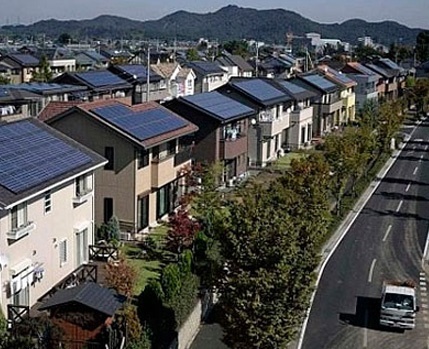
The cost of systems depends on their type, area, material used in the manufacture. From year to year there is a steady downward trend in prices for all types of solar installations - solar systems.
This makes them more accessible to the general public. That's just not everyone is ready to make such a purchase.
But, if desired, you can build an effective solar heating system with your own hands, spending significantly less money.
A familiar heating system that performs its functions perfectly for many years is becoming more expensive. The reason for this is the global rise in price of energy resources around the world. The owner’s natural desire is to save on heating, which eats a significant portion of the family budget.
So the solar heating system can fully replace the usual solid fuel, gas or any other. It all depends on the type and size of the room in which it will be used.
An option suitable for a granary is not suitable for a residential building, and a system that satisfies the needs of a summer cottage cannot cope with heating a 2-story mansion.
Complete replacement of traditional solar heating is sometimes problematic. The owner fears that the system may not be able to cope or there is not enough physical space to install the required number of panels.
Therefore, they often use a combined heating system, not completely giving up installed gas (electric or other) equipment. The level of replacement of conventional solar heating can reach 90%.
Also, the annual number of sunny days of the area in which the home is located is important. Moreover, the average daily temperature is not so important. Many installations effectively absorb light in winter frosty days (solar collectors using antifreeze as a coolant).
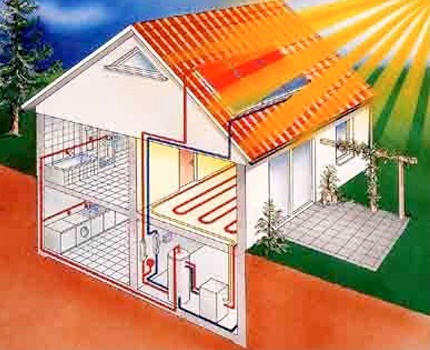
Where solar installation will be most effective
In the issue of replacing heating with a solar installation, a number of factors affecting its effectiveness must be taken into account.
Firstly, you need to choose the right type of solar system. In this matter, the area of the room and its purpose should be taken into account. Most often this is a private house in which a family of 4-5 people lives.
Secondly, carefully calculate the heat demand, based on the maximum consumption in the cold season. Compare these numbers with the amount of energy generated 1 sq. Km. m of solar installation. It remains to calculate the area of the solar structure that can cope with the heating of a particular room.
The resulting value will be the main factor in determining the location of the system. Typically, homeowners prefer to use the roof or wall of the house. Rarely use the house area or the roof of the garage. Sometimes they build special stands for installation.
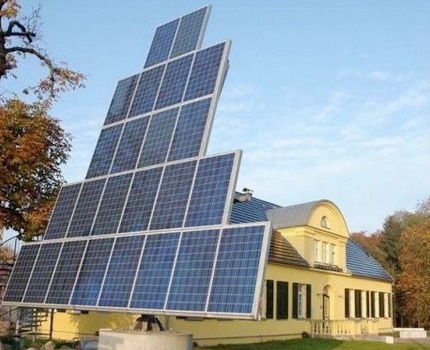
It is important that nothing interferes with the free penetration of sunlight onto a light-absorbing surface. You need to choose a south, southeast or southwest wall or part of the roof.
Having decided where the solar panels will be placed, a preliminary preparation of the dwelling will be carried out:
- Free up space. Cut down extra plantations if they interfere.
- Strengthen the roof. Here you must not forget about how much weight the proposed design will have.
- Additionally insulate the building. After all, it is pointless to heat the street.
Thirdly, it is necessary to solve the question: to buy or build a heating system yourself.It all depends on financial capabilities and the desire to spend time on the manufacture of the structure.
Having chosen the second option, you need to understand the principle of operation of the desired system in order to properly assemble everything.
Possible options for solar heating
The options for constructing a solar heating system are completely dependent on the wishes of the owner of the household:
- The use of factory products. Purchase of ready-made collectors with self-installation and installation.
- The construction of a pilot project. It is needed to verify the effect of using the system for the further production of accurate calculations.
- Self-completion of a full cycle of work. Calculation, design, construction "from scratch" of the solar system, its installation.
Option number 1. It implies choosing the right location for solar installations, because the effectiveness of their use will depend on this. Installation will also require special skills.
It will not be necessary to calculate the number of panels - it will be enough to voice all your wishes to the equipment supplier. Still it will be necessary to answer the clarifying questions of managers - everything, the selection of the optimal number of panels (collectors) will occur without any difficulties.

Option number 2 - construction of a pilot project. It will be the best solution for doubters. After all, the final decision to replace the heating system is difficult to make right away. To build a small solar collector (air or water) and test it “in action” will be a rewarding experience.
Having assessed the real costs of manufacturing, comparing them with the market value of similar systems and calculating the savings from use on the farm, it will be easy to make a responsible decision.
Option number 3 - the choice of true masters.
For complete heating of the facility, you will need to carry out tremendous work:
- Calculate the required area of the solar system.
- Determine the place of future installation, strengthen it.
- Additionally insulate the home.
- Purchase all the elements for the construction of the system.
- To build solar battery.
- Install the constructed system, focusing on the basic requirements - the angle of inclination relative to the incidence of sunlight.
Performing a full cycle of work on the system cannot be called an easy task, but the process is extremely exciting. In addition, it saves a pretty substantial amount.
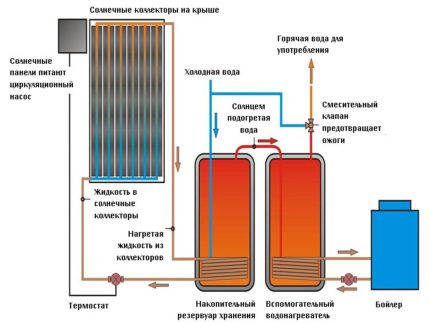
Types of installations for converting solar energy
Depending on the principle of operation, two types of devices that absorb sunlight are distinguished:
- Batteries on photoelectric converters. Representing systems of series-connected or parallel-connected semiconductor elements. They supply current to power domestic heaters.
- Solar collectors. Panels with a system of tubes filled with coolant: air, non-freezing mixture or water. They supply solar-heated coolant to the heating circuit.
We consider each option separately.
Solar panels
The solar battery converts the absorbed light into electricity. It consists of solar cells (most often silicon), capable of immediately extracting direct electric current from solar radiation.
Such an installation can be used to ensure the operability of electric heating equipment. It must be connected to the power supply system of the home.
The conversion efficiency of solar radiation from this installation is from 5% to 20%, depending on the type of solar processing device. Productivity 1 m2 solar battery - 120 watts.
It remains to calculate how many squares of area will be needed to meet the needs of a particular household, based on the size of the home, individual heat requirements and the level of insulation of structures.

For heating, solar panels are most efficiently used in the southern regions. Their main disadvantage is a decrease in efficiency at dusk and cloudy weather, a complete lack of performance at night.
To make a solar battery with your own hands, you will need to first assemble the frame, solder the solar cells, then carefully place everything and use a sealant.
For the manufacture of the frame used wooden battens, aluminum corners. It all depends on the size of the assembly and the place of its installation. Solar cells - silicon wafers - the most expendable part of the design. They are monocrystalline and polycrystalline. The first ones are somewhat more expensive, but their productivity is 5% higher.
Making them yourself is impossible. Photoelectric converters are best purchased with soldered conductors.
They have to be placed on the base of fiberboard, then fixed in the frame, bring the wires from the elements out and fill all the holes with sealant. Allow the structure to dry well and cover with a glass or clear plastic lid.
Installation schemes and methods for connecting solar panels are described in this article.
Solar collectors
A fundamentally different way of converting absorbed light from collectors. At the heart of their work is the coolant passing through the pipes.
Depending on the design, there are three main types of collectors that are most often used for the construction of a solar heating system:
- Flat. Heat sink - their absorber is made of sheet metal with a blackened outer surface. When heated, it transfers energy to the coolant of the heating system.
- Vacuum Collector vacuum type system made according to the scheme of thermoses, due to which the heat received from the sun is almost twice as good.
- Hubs The device is equipped with a concave mirror part with a large surface area, focusing sunlight on a small area of the absorber.
The most common solar systems in everyday life are equipped with a tube system made in the form of parallel-connected elements or a coil. The tubes are filled either with industrial water, or with a mixture of water with a non-freezing liquid or air.
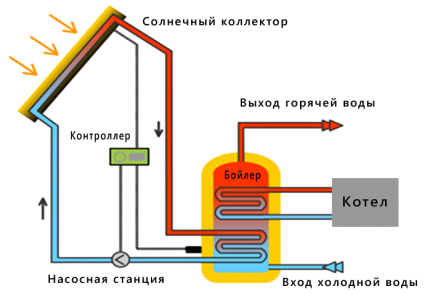
An air installation can be used as an additional source of heating. It is not able to fully provide home ownership with heat, regardless of the region of its location. The main feature of this type of solar system is air, which acts as a coolant.
Tubular systems are quite actively used for heating all year round. Antifreeze or a mixture of antifreeze is heated under sunlight, then passes through the internal heat transfer tubes, then sent to the storage tank.
The movement of the fluid is stimulated by the pump, thanks to which it moves from the tank to the heating system. The heated coolant displaces the cooled part of the liquid, which will again return to the collector and heat up.
The principle of operation of a flat solar system is based on the penetration of sunlight into the panel where the heat absorber is located. It heats up and radiates heat, which is transmitted to the fluid circulating through the metal tubes (most often, copper).
What can you build on your own?
You can build a solar heating system using an air-type collector with your own hands. It is best placed on the south wall of the building.
The larger the area of the heated room, the greater the area the collector will occupy - possibly the entire wall of the house. Also, this solar system can be built in the attic.

Solar collector heating the air mass - performs its functions of heating due to air flows passing inside the system. The coolant circulates through the circuit, cooling, again enters the system. Air flow can occur naturally or with a fan.
As for the materials for the manufacture of the air manifold, here you can use various improvised tools. There is no single rule.
Home craftsmen improve this type of solar system, assembled at home. Someone seeks to get a cheaper option, while sacrificing efficiency, while others - on the contrary.
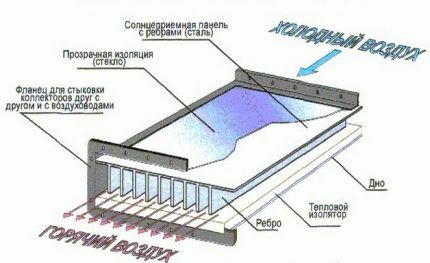
Consider the main methods.
Features of installing a tubular solar system
The tubular type solar system for heating can be used in various regions. It does not depend on external temperature. The main thing is that the installation receives the maximum amount of sunlight.
Antifreeze used as a coolant does not freeze at low temperatures. On clear winter days, the amount of sunlight exceeds the amount of light entering in the summer.
The tubular solar collector consists of a system of transparent vacuum tubes interconnected. They contain a substance with a low boiling point. Boiling, it evaporates, transfers its heat to the copper tip and flows down, where everything repeats again.

Vacuum tubes absorb up to 90% of all solar radiation (visible and infrared). Solar energy, converted into heat, is supplied to the coolant.It transfers this energy further through the system - to the heat exchanger located in a special storage tank.
The movement of coolant and water through the heating systems is due to the pumps. It is important that the tank has good thermal insulation. As a rule, there are two heat exchangers: one is connected to an additional heater, the second to collectors.
In homes with this type of solar installation, it is beneficial to additionally connect a system of underfloor heating. This allows you to more efficiently heat the building.
As for the installation of tubular collectors, it can be installed on its own. The only thing to consider is the working angle - it must be at least 20 °.
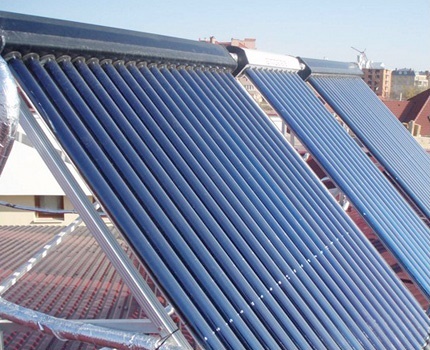
It will not work to build a vacuum installation with your own hands - it is impossible to make vacuum tubes at home. This is done by factories specializing in the production of vacuum solar systems.
Flat solar installation
Often a flat solar collector is used for heating.
For its construction you will need:
- metal frame;
- strong bottom;
- thermal insulation layer;
- black absorber layer (adsorber);
- transparent cover - plastic, glass;
- fluid tubes (copper, aluminum).
The design must be equipped with inlet and outlet nozzles and a pump for efficient fluid circulation.

You can install a flat collector at any angle, a prerequisite is to clean from snow and dust. It is especially good for warm climates.
In the cold season, low efficiency and high heat loss are observed. Which casts doubt on the use of this solar system alone for proper heating. It will optimally use a flat solar installation together with a gas, electric or solid fuel type of heating.
We offer you to read articles about the home-made assembly of solar heating systems:
- How to make a solar collector for DIY heating - step-by-step guide
- How to make a solar battery with your own hands: methods of assembly and installation of a solar panel
Once again about expediency
To use solar energy instead of the usual energy for heating is beneficial. Depending on the selected type of solar system, the savings on the consumption of paid heat can be up to 100%.
An option for a complete replacement of the heating system is the use of manifolds with vacuum tubes. This is a rather expensive project at the initial stage. In the future, he can guarantee complete energy independence, having paid for himself in 6-8 years.

Solar service life up to 25 years. They require little maintenance - periodic cleaning of surfaces from snow, dust, debris. As for the repair, it can be carried out on their own. A significant drawback is that flat collectors and solar panels are “afraid” of hurricanes.
Such heating is safe for residents of the home and the environment. It is completely free and does not depend on the exchange rate, energy prices.
Conclusions and useful video on the topic
The video will demonstrate the process of constructing a solar battery with your own hands:
Visual aid for the construction of an air heating system:
DIY manufacturing technology of a flat solar installation:
Solar installations or solar heating systems have proven themselves around the world. They allow you to get heat for free, reducing the cost of paying utility bills for heating from 30%.
It is possible to completely replace energy with solar energy in your heating system. Another significant advantage is that you can assemble a solar installation with your own hands.
Do you have practical skills in assembling or operating solar heating systems? Share your knowledge, ask questions on the topic and participate in discussions. The comment form is located below.

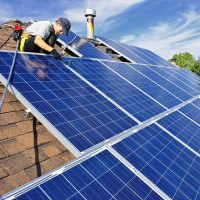 Solar panels for summer cottages and houses: types, principle of operation and calculation procedure for solar systems
Solar panels for summer cottages and houses: types, principle of operation and calculation procedure for solar systems  Solar panels for heating a house: types, how to choose and install them correctly
Solar panels for heating a house: types, how to choose and install them correctly 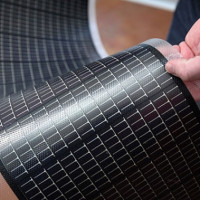 Flexible solar panels: an overview of typical designs, their characteristics and connection features
Flexible solar panels: an overview of typical designs, their characteristics and connection features 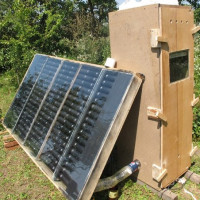 How to make a solar collector for DIY heating: a step-by-step guide
How to make a solar collector for DIY heating: a step-by-step guide  The principle of operation of the solar battery: how the solar panel is arranged and works
The principle of operation of the solar battery: how the solar panel is arranged and works  How to make a solar battery with your own hands: methods of assembly and installation of a solar panel
How to make a solar battery with your own hands: methods of assembly and installation of a solar panel  How much does it cost to connect gas to a private house: the price of organizing gas supply
How much does it cost to connect gas to a private house: the price of organizing gas supply  The best washing machines with dryer: model rating and customer tips
The best washing machines with dryer: model rating and customer tips  What is the color temperature of light and the nuances of choosing the temperature of the lamps to suit your needs
What is the color temperature of light and the nuances of choosing the temperature of the lamps to suit your needs  Replacement of a geyser in an apartment: replacement paperwork + basic norms and requirements
Replacement of a geyser in an apartment: replacement paperwork + basic norms and requirements
I have seen a lot of solar panels abroad. This is a good saving. I live in the southern region myself. We have many sunny days, but nevertheless the use of solar panels is not common. And I want to try installing in a country house. I am studying information about this. All, of course, is not easy. Most likely I’ll buy a ready-made one and install it myself. While thinking about it.
For regions where there are a large number of bright sunny days in a year, installing solar panels is economically feasible, especially given the current rise in energy prices and ever-increasing environmental concerns. The solar panels themselves, too, are gradually becoming cheaper and improved, so I think that in the future they will be introduced everywhere with us.
In childhood, we made solar panels with our own hands, I don’t remember any of which: either from photoresistors, or from photodiodes. It worked. I don’t know how much it is all economically beneficial for Russia. We have people (working in electric networks) who can make a solar battery with their own hands, act even more efficiently from an energy point of view. They just learn to stop the electricity meters, negotiate with the supervisors. And they get free energy without any batteries. That's real.